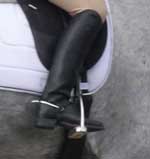- Equipment
- Arena
- For the Horse
- For the Rider
Equipment for the Dressage Rider
Attire
Dressage attire is fairly strict in competition. U.S. riders competing at the fourth-level or below are required to wear dark coats with light breeches. They must also wear a colored stock (a broad band worn around the neck), a collar or tie, light-colored gloves, black boots, and a helmet, derby or top hat.
Riders in international competitions must wear a dark navy or black coat; a white or cream stock; white gloves and breeches; black dress boots; spurs; and a top hat. Women must have their hair up in a bun or hairnet.
Aids
Aids are prompts given to the horse by the rider to change gaits, turn or perform other movements. In dressage, there are both natural and artificial aids.
Natural Aids
Natural aids are traditionally the riderís seat, legs, hands and voice. However, in competition it is not considered good form for riders to use their voice during competition.
Seat
An experienced rider will have a good seat, meaning that when riding there is very little movement at the hip joints and the pelvis. The seat is essential because it helps control the horse's movement. Sitting in the lowest part of the saddle, weight should be distributed evenly on both seat bones. Feet should be facing forward with toes up. From behind, the body is upright and straight. From the side, there should be a vertical line through the ear, shoulder, hip and heel. The head should be looking straight ahead.
Legs
A riderís legs should always be in contact with the horse. They signal to the horse the desire to move forward and can also indicate direction.
Hands
Through the reins, a riderís hands convey its wishes to the horse. However, they should never be used alone. Along with the seat and legs, they help control the horse's readiness, indicate direction and help to balance the horse.
Artificial Aids
Artificial aids are comprised of whips and spurs.
Whips
Althought whips are never used in competition, they can be helpful during training to reinforce leg commands if the rider is lacking in strength. Usually, whips are about three feet long and when used properly should touch the horse behind the riderís leg. Riders should never take their hands off of the rein when using a whip.

Spurs
Spurs are worn on the heels of boots and, like the whip, used to reinforce or refine the use of the leg. Some levels of competition require them to be worn, although they should only be used when they are required.
Sources for this page: 1, 3 and 7
